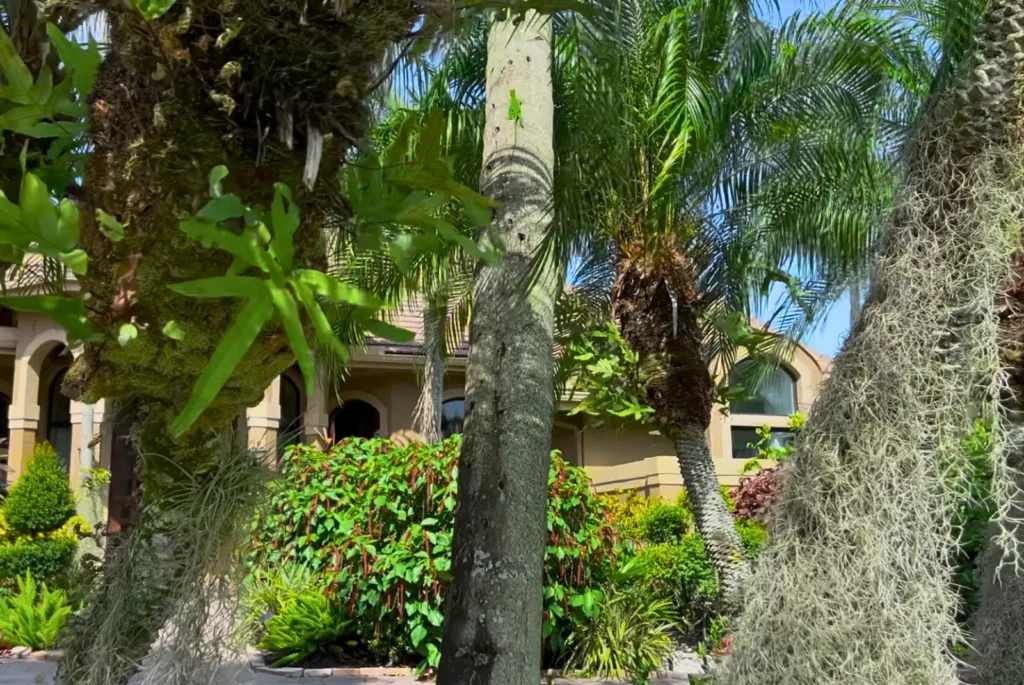Why Does Florida Have So Many Iguanas?
In sunny Florida, it’s almost impossible not to spot an iguana sunning itself outside, darting across the road, or swimming in a canal. You’ve probably thought: why does Florida have so many iguanas? To those visiting the sunshine state, these big green lizards might seem exotic, even exciting. But for Florida homeowners, the iguana problem is very real.
So why does Florida have an iguana problem? And is it really as bad as people say? Let’s break it down.
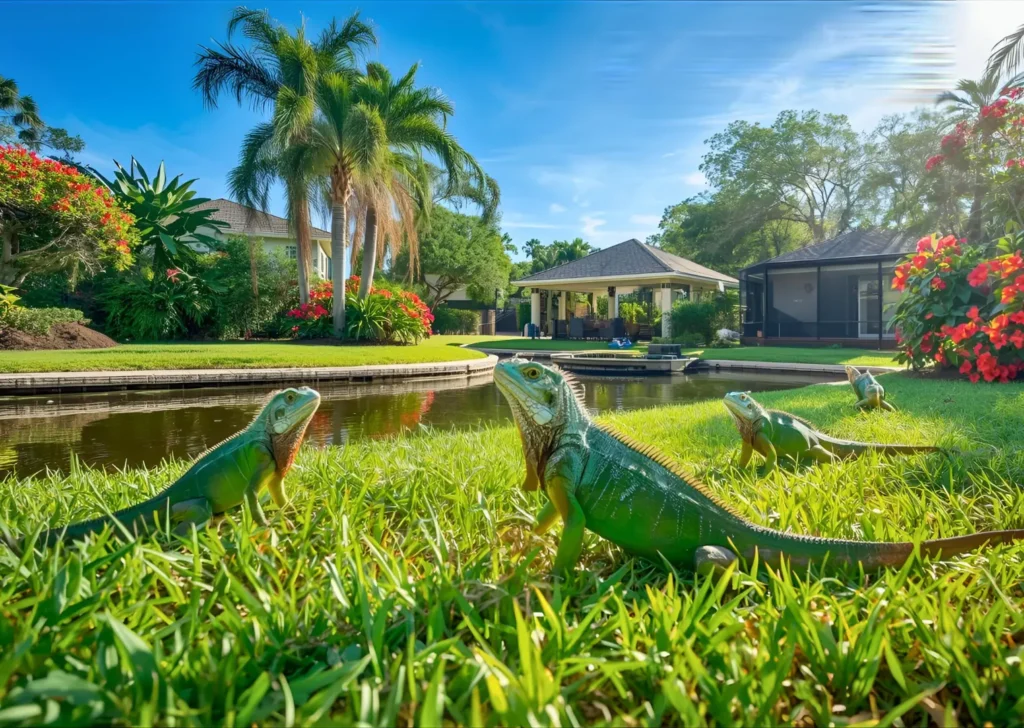
Affiliate Disclosure: Some of the links on this page are affiliate links. This means if you click on a link and make a purchase, Dont Iguana may earn a small commission, at no extra cost to you. We only recommend products and tools we believe are helpful for keeping your Florida property iguana free!
Iguanas Are Not Native to Florida
Most people don’t realize that green iguanas are not native to Florida. They originate from Central and South America, where they thrive in tropical forests and wetlands. Those regions also have natural predators (like snakes and large birds) that keep iguana populations in check. Florida lacks those natural controls, which is why more than fifty years after their introduction, iguanas have become an overpopulated invasive species, creating serious problems for homeowners across the state.
Green iguanas first appeared in Florida in the 1960s. Some likely arrived hidden in shipments of fruits, vegetables, and ornamental plants, materials they eat and even lay eggs in. With no predators here, the eggs hatched and the iguana population quickly expanded.
Another major pathway was the pet trade. Iguanas were sold widely as exotic pets, but because they grow several feet long and become difficult to manage indoors, many were eventually released by overwhelmed owners. Once free, these reptiles found Florida’s subtropical climate and abundant food sources ideal for survival. Hurricanes and tropical storms also played a role, destroying facilities and allowing captive iguanas to escape into the wild.
This history means that the iguanas you see today aren’t just random visitors passing through your yard, they are part of a self sustaining invasive population. Left unmanaged, they can cause property damage, destroy gardens, and create ongoing challenges for residents. But that’s where we come in, with helpful tips like building your own traps, and what tools you need to do so!
Florida’s Climate Is Perfect for Iguanas
One of the biggest reasons Florida has an iguana problem is the climate. The state’s warm, subtropical environment is ideal for green iguanas, making Florida one of the only places in the United States where these non-native reptiles can survive year round.
Mild winters mean iguanas don’t experience the natural die offs that occur in colder regions. Abundant rainfall supports lush vegetation, creating a constant food supply. At the same time, Florida’s plentiful sunshine allows iguanas to bask and regulate their body temperature, which is essential for digestion, breeding, and overall health.
Even when rare cold snaps occur, iguanas often only enter a temporary state of “cold shock.” This is when they stiffen up and may fall from trees, but once temperatures rise again, most recover quickly and resume normal activity. In other words, Florida’s weather doesn’t slow them down for long. Keep an eye on the temperature easily with this outdoor thermometer we love.
For homeowners, this means iguanas aren’t seasonal visitors. The climate allows them to remain permanent residents, which makes control and prevention strategies especially important across South Florida neighborhoods. Ever wonder what happens to iguanas during a hurricane? Learn more about it here!
Florida Provides Endless Food for Iguanas
Another major reason Florida struggles with an iguana problem is the abundance of food sources. Green iguanas are herbivores, and Florida’s landscaping and backyards unintentionally create a buffet that allows these reptiles to thrive.
Ornamental plants such as hibiscus, bougainvillea, orchids, and roses are not only favorites for humans but for iguanas as well. Homeowners often notice these plants stripped bare almost overnight. Fruit trees including mango, avocado, banana, and fig are also prime targets, and vegetable gardens are rarely spared. Even freshly planted lawns can become a food source for hungry iguanas.
Since having the wrong plants can unintentionally attract iguanas, it’s important to choose iguana resistant landscaping. We put together a free downloadable guide listing which plants deter iguanas and which ones attract them. You can also protect vegetable gardens with garden netting or lightweight fencing to reduce damage. By making your yard less appealing as a food source, you can significantly lower the chances of iguanas turning it into their personal dining spot.
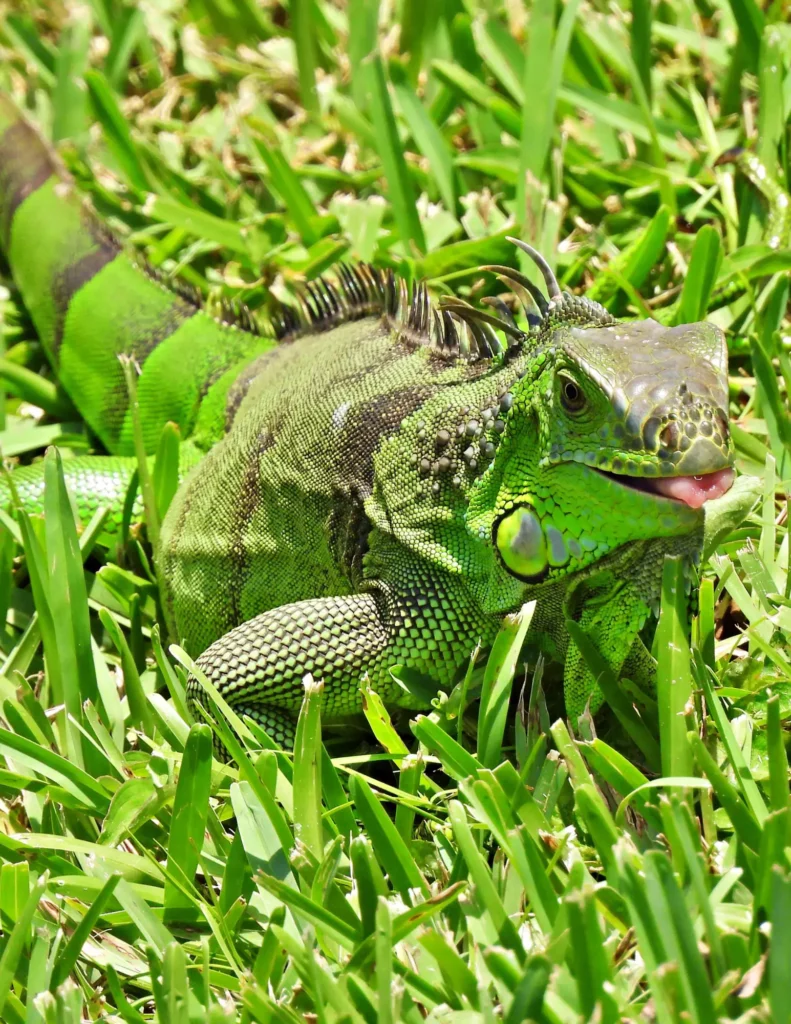
Iguanas in Florida Have Few Predators
Another major reason iguanas in Florida are a growing problem is the lack of natural predators. In their native habitats in Central and South America, iguanas are regularly hunted by snakes, large birds, and mammals, which helps keep their populations in check. Florida, however, does not provide the same predator balance, allowing these non-native reptiles to thrive with little resistance. You might assume alligators would prey on them, but in reality, iguanas and alligators rarely interact, and iguanas are rarely at risk from them.
While raccoons, dogs, owls, or even squirrels may occasionally prey on young iguanas, adult iguanas face virtually no threats. Without natural checks, populations expand quickly, particularly in urban neighborhoods, along canals, and in areas with abundant landscaping.
For homeowners, proactive management is essential. This includes habitat modification, protective barriers such as mesh or fencing, and deterrents like reflective tape or shiny pinwheels, all designed to keep iguanas from invading yards and causing property or garden damage.
Iguanas Reproduce Quickly in Florida
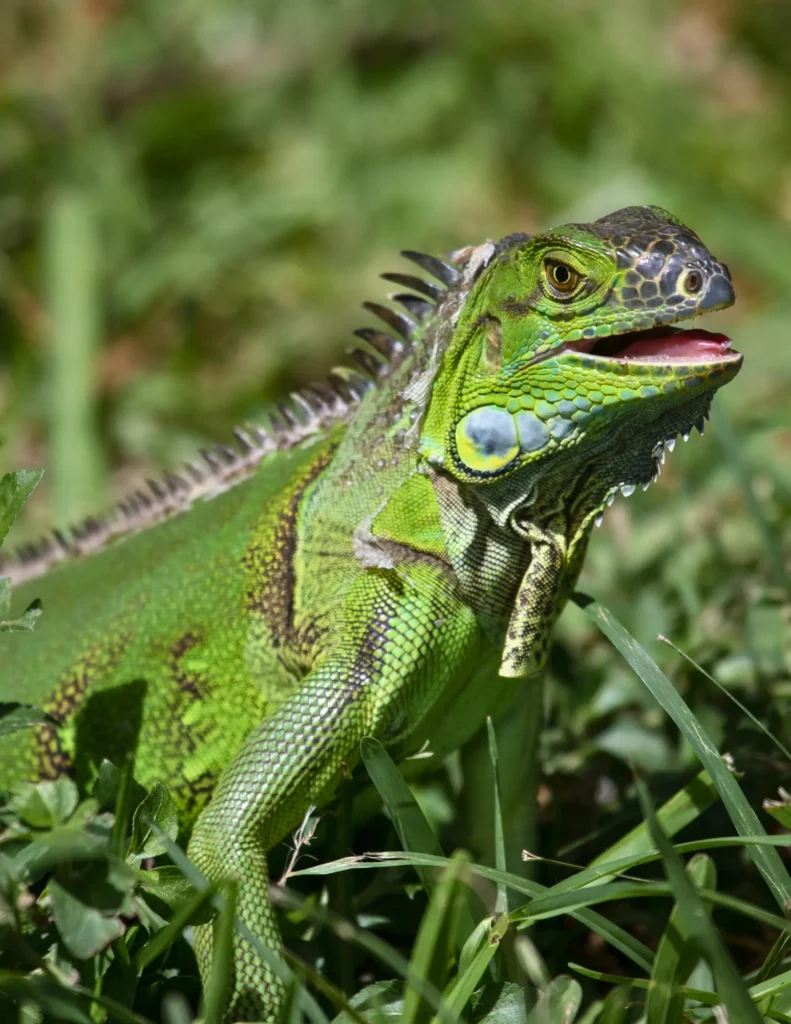
One of the biggest challenges in managing Florida’s iguana problem is their rapid reproduction. Female green iguanas can lay anywhere from 20 to 70 eggs per year, usually in burrows along seawalls, sidewalks, gardens, or other soft, sandy soil. Because Florida’s climate is mild and vegetation is abundant year round, hatchlings have a high(ish) survival rate, allowing populations to grow quickly.
A single female and her offspring can establish a small colony in just a few years, turning a minor yard nuisance into a full blown infestation. For homeowners, this rapid reproduction means that ignoring the problem is not an option. Even if you remove a few adult iguanas, new ones can quickly take their place. This makes proactive management critical for preventing long term infestations.
Human Development Makes the Iguana Problem Worse
Florida’s human development has inadvertently created ideal habitats for iguanas. The rapid urban growth has unintentionally made life easier for them. New neighborhoods, canals, yards, and docks all provide ideal hiding and nesting spots, giving these guys more opportunities to establish themselves long term.
Backyards, swimming pools, and landscaped gardens offer not only shelter but also a reliable food source, while freshly dug soil from construction sites creates perfect burrowing locations for laying eggs. Iguanas are excellent climbers and swimmers, which means they can easily move between properties, spreading into new areas as communities expand.
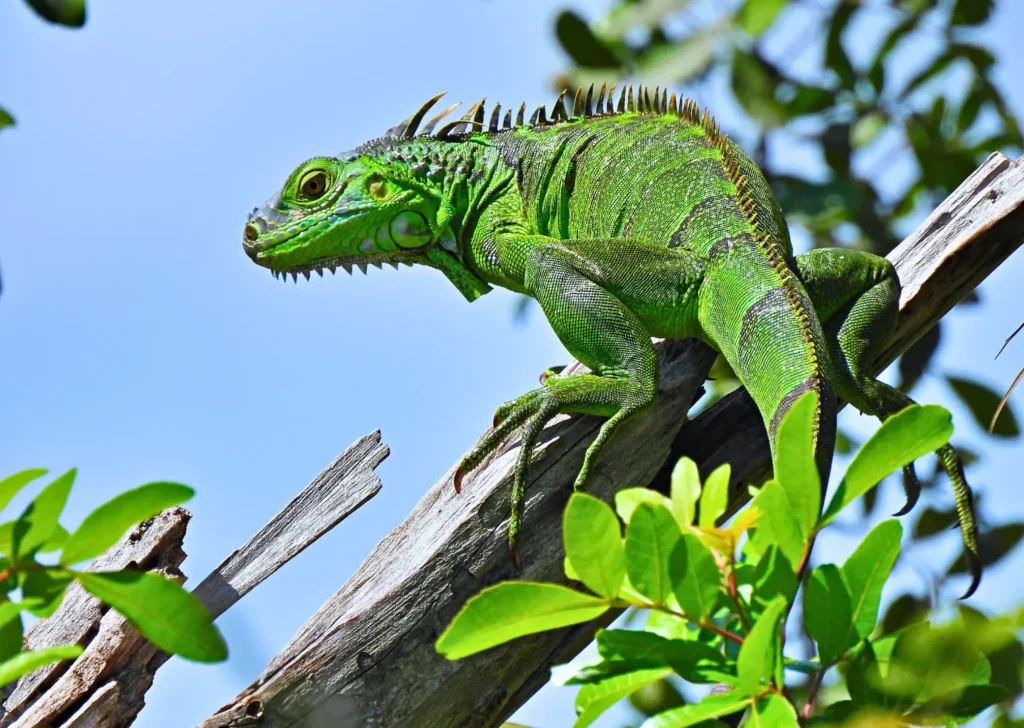
Why the Iguana Problem in Florida Matters
At first glance, the iguana problem in Florida may seem like just another part of everyday life. But for homeowners, the Florida iguana problem comes with very real consequences. Understanding the risks can help you take proactive steps to protect your property, gardens, and overall yard environment.
Property Damage from Iguanas in Florida
Iguanas are expert diggers. Their burrows can undermine seawalls, sidewalks, canal banks, and even foundations, leading to costly repairs. Even small holes left unchecked can grow over time, creating structural problems that are expensive to fix. Addressing burrows early is key to preventing long term damage. Fill any spots with compact soil, it’s great for the earth and keeps iguanas out.
Landscaping and Garden Loss
Green iguanas are voracious herbivores, and the Florida iguana problem often hits home in yards and gardens. Ornamental plants, fruit trees, vegetable gardens, and newly planted lawns are all at risk. Homeowners often find hibiscus, bougainvillea, mango, or avocado trees stripped bare. For gardeners, iguanas can undo months of work almost overnight.
Sanitation Concerns
Iguanas leave droppings wherever they feed, rest, or dig. Pool areas, patios, docks, and gardens can become messy and potentially unsanitary. While not poisonous, their feces can carry bacteria such as Salmonella, which can affect pets and children who play outdoors. If you have an in-ground pool, we recommend putting a fence around it. This prevents the iguanas from getting in, and keeps your pets and kids safe as well.
Ecological Impact of Non-Native Iguanas
Non-native iguanas compete with local wildlife for food and habitat and may spread invasive plant seeds through their diet. This disrupts Florida’s delicate ecosystems, affecting native birds, reptiles, and plants. While homeowners may focus on backyard issues, iguanas also have broader environmental consequences that can’t be ignored.
For homeowners, the takeaway is clear: ignoring iguanas allows problems to multiply. Simple strategies such as planting iguana resistant landscaping, installing mesh or fencing around gardens, and reducing burrowing opportunities can help protect your property. Addressing the issue early not only preserves your yard and garden but also minimizes long term repair costs and ecological impact.
Why Florida Can’t Fix the Iguana Problem Permanently
Many wonder why the state doesn’t just eradicate all iguanas. The truth is that once invasive species establish themselves, elimination is nearly impossible. Like we discussed, green iguanas reproduce quickly, have few predators, and adapt easily to the human environments of Florida life.
In their native habitats, iguanas are kept in check by snakes, large birds, and mammals. In Florida, very few animals prey on adult iguanas, and predators that might eat juveniles, are insufficient to significantly reduce numbers. Without these natural checks, populations continue to expand.
And even when a few adults are removed, new hatchlings can quickly replace them. Their ability to climb, swim, and hide in dense landscaping allows iguanas to evade removal efforts, making population control pretty challenging.
For homeowners, the focus isn’t on eradication, it’s on prevention and management. Effective strategies include humane trapping and removal of adult iguanas, planting iguana resistant landscaping to reduce food sources, installing protective barriers to block burrowing and entry, and using deterrents to discourage repeat visits. By combining these approaches, you can protect your property and gardens from the damage iguanas cause.
Frequently Asked Questions About Florida’s Iguana Problem
Are Florida iguanas aggressive?
Florida iguanas are not usually aggressive toward people. They prefer to escape rather than fight but may whip their tails or bite if cornered. Male iguanas can be more territorial during breeding season, and property damage is a more common concern than personal injury.
What eats iguanas in Florida?
Few animals regularly eat iguanas in Florida. Raccoons, hawks, owls, snakes, and squirrels may occasionally prey on young iguanas, but not enough to control the population. Humans are the main predator, as trapping and removal is permitted and effective.
What damage do iguanas cause?
Iguanas cause serious property and landscaping damage. Burrows weaken seawalls, sidewalks, and canal banks. Their feeding destroys plants, fruit trees, and vegetable gardens. Droppings (poop) near pools and patios create sanitation issues with potential salmonella. Overall, they are one of the most costly invasive species for Florida homeowners.
Are iguanas poisonous to dogs?
Iguanas are not poisonous or venomous. However, they can carry bacteria like salmonella in their feces. Dogs that bite or eat iguanas risk illness or injury from claws or tail whips, so keeping pets away is safest.
Do iguanas come out at night?
No, iguanas are active during the day, basking in sunlight, feeding, and digging burrows. At night, they rest in trees or burrows. Most homeowner encounters happen in the morning or late afternoon before the sun goes down.
How do you scare away iguanas?
To scare away iguanas in Florida, make your yard less inviting. Reflective tape, wind chimes, fencing, and mesh barriers can discourage visits. Removing iguana friendly plants and blocking burrow sites further reduces the likelihood of repeat appearances. Prevention combined with active deterrents is the most effective approach.
Why are iguanas bad for Florida?
Iguanas are bad for Florida because they cause extensive property, landscaping, and environmental damage. Their burrows weaken sidewalks and foundations, leading to costly repairs. They strip ornamental plants, fruit trees, and vegetable gardens, often leaving yards completely destroyed. Iguana droppings spread bacteria like salmonella around pools and patios, creating health risks. Beyond homes, iguanas also harm Florida’s ecosystems by competing with native species and spreading invasive plant seeds, making them one of the state’s most damaging invasive animals.
